The intraoral scanner (IOS) market continues to evolve rapidly, with manufacturers constantly pushing the boundaries of what's possible in digital dentistry.
In this edition of our iDD Compares series, we'll take a closer look at some of the latest scanners that represent different approaches to digital impression technology:
- Medit's flagship i900
- SHINING 3D's Aoralscan 3
- SHINING 3D's latest flagship Aoralscan Elite
- Dentsply Sirona’s CEREC Primescan
- Dentsply Sirona's cloud-based Primescan 2
Our goal at iDD is to provide dental professionals with unbiased, practical comparisons based on real clinical usage.
Whether you're considering your first scanner purchase or looking to upgrade your existing system, this comparison will help you understand how these devices perform in actual clinical settings.
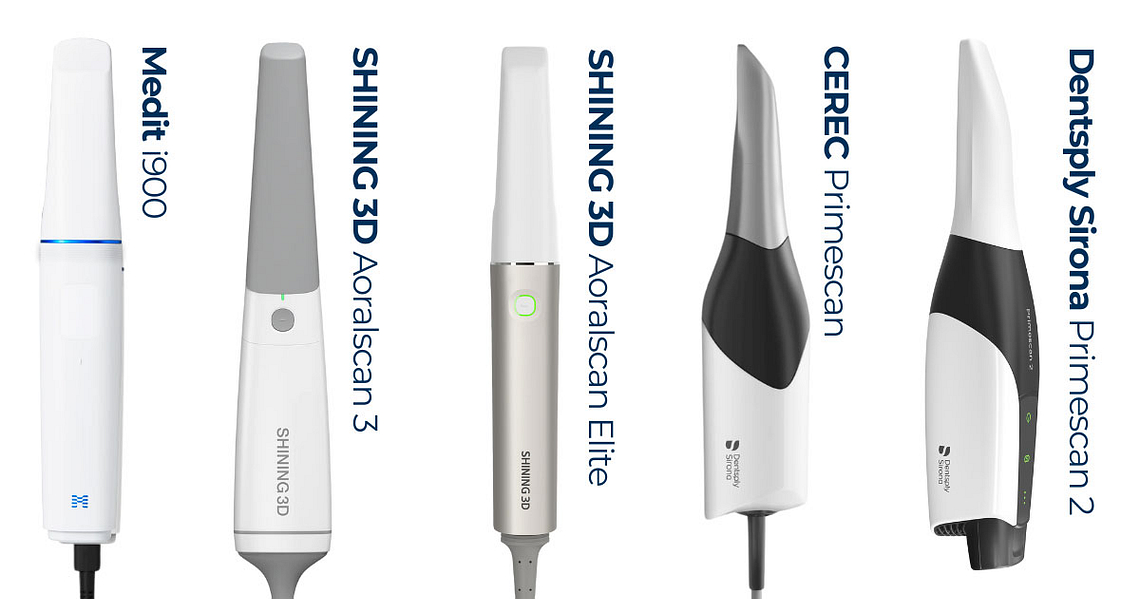
Intraoral Scanners at a Glance
Before diving into the details, let's take a quick look at how these scanners compare in terms of key specifications and pricing:
Medit i900
- Price (USD): $20,999 (with laptop)/$18,999 (without laptop)
- Weight: 165g (one of the lightest scanners available)
- File Formats: STL, PLY, and OBJ
- Cloud Platform: Medit Link
- Notable features: Medit software is market leading, i900 has largest scanning tip of any Medit scanner.
SHINING 3D Aoralscan 3
- Price (USD): $10,999
- Weight: 240g
- File Formats: STL, PLY and OBJ
- Cloud Platform: SHINING 3D Platform
- Notable features: relatively low cost, narrow scanning head.
SHINING 3D Aoralscan Elite
- Price (USD): $19,999
- Weight: 124g (currently one of the lightest scanners on the market)
- File Formats: STL, PLY and OBJ
- Cloud Platform: SHINING 3D Platform
- Notable features: Intraoral photogrammetry technology, ultra-lightweight and small design
Dentsply Sirona CEREC Primescan
- Price (USD): $23,000
- Weight: 457g (with disposable scanner sleeve), 524g (with metal scanner sleeve)
- File Formats: STL and PLY
- Cloud Platform: DS Core
- Notable features: CEREC - one of the best chairside systems in the world
Dentsply Sirona Primescan 2
- Price (USD): $24,995
- Weight: 542g (including battery)
- File Formats: STL and PLY
- Cloud Platform: DS Core
- Notable features: First and only cloud-based scanner, Dentsply Sirona's only wireless scanner
Scanning Methodology
To ensure a fair and comprehensive comparison, we go through the same scanning process with each scanner.
I scanned the same patient case with each device - a 14 and 15 crown prep, immediately one after the other. This allows for direct comparison across all scanners. All scans were performed by me, Dr. Ahmad Al-Hassiny, to minimize operator variability.
Multi-faceted Analysis: We analyzed the results in both native software and third-party applications, focusing on:
- Scan quality (color and monochrome)
- File characteristics (formats, sizes, mesh density)
- Clinical usability (margin clarity, overall accuracy)
Deviation Analysis: We used CEREC Primescan as the reference point for this comparison’s deviation analysis, being as it is known as it is widely cosnidered a gold standard for accuracy in intraoral scanning. Below are the results of the individual scan, pictures of the color scan, exported STLs, tessellated mesh, and a close-up of the prep margin.
Scanning Results
Native Software Scans
Every intraoral scanner is equipped with its own scanning software. Most scanners can automatically remove scan artefacts such as movable soft tissue, cheeks, and tongue through AI, with some performing better than others.
Medit and Aoralscan scanners do this very well. Most if not all soft tissue interferences are ignored completely and the AI overall is excellent in these scanners.
The AI removal of soft tissue artefacts with the Primescan 1 and 2 is notably less aggressive and you need to have much better soft tissue retraction when using these. Something Dentsply Sirona needs to improve in my opinion.
We can preview how these scanners capture color (called texture) using the scanner’s native software.
Color Scans
Every scanner captures color slightly differently, depending on how accurately it can pick up the light bouncing back off the prep and adjacent teeth. The software's algorithms also depend on how accurately they can convert this data into color.
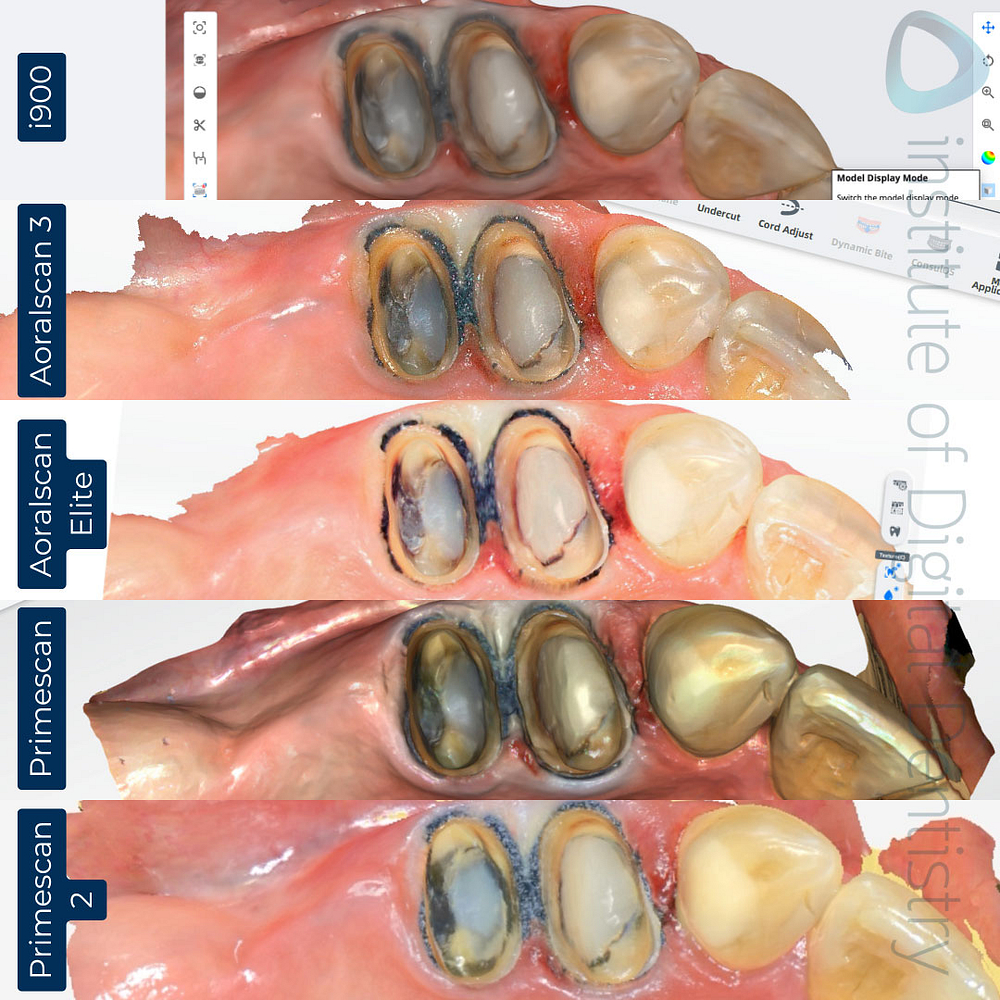
Medit i900 produces the classic illustrative or ‘cartoon-like’ Medit texture with great resolution but less photo-realistic than the SHINING 3D scanners.
Aoralscan 3 is similar to the Elite but with slightly less definition or brightness in the color rendering. It still maintains the photo-realistic appearance typical of Chinese IOS devices. Interstingly Aoralscan 3 appears more sharp.
Aoralscan Elite shows the most photorealistic scans of the group, with high brightness and natural color reproduction. This is characteristic of SHINING 3D's approach to scan visualization and something a lot of clinicians like in my experience.
Primescan 1 displays its usual CEREC cartoon style aesthetic, with its bold and rich texture and color scan capture. Just at initial glance, the PS1 scan seems to have the highest quality resolution of the color scans within the native softwares.
Primescan 2 significantly departs from the traditional CEREC aesthetic, showing more photorealistic textures than its predecessor. However, when viewed in DS Core, the scans do appear in a somewhat lower resolution compared to local viewing with PS1 scans.
Monochrome Scans
Monochromatic scans can also be taken and previewed in their native software. Examining the scans in monochrome reveals important details about each scanner's ability to capture critical clinical information:
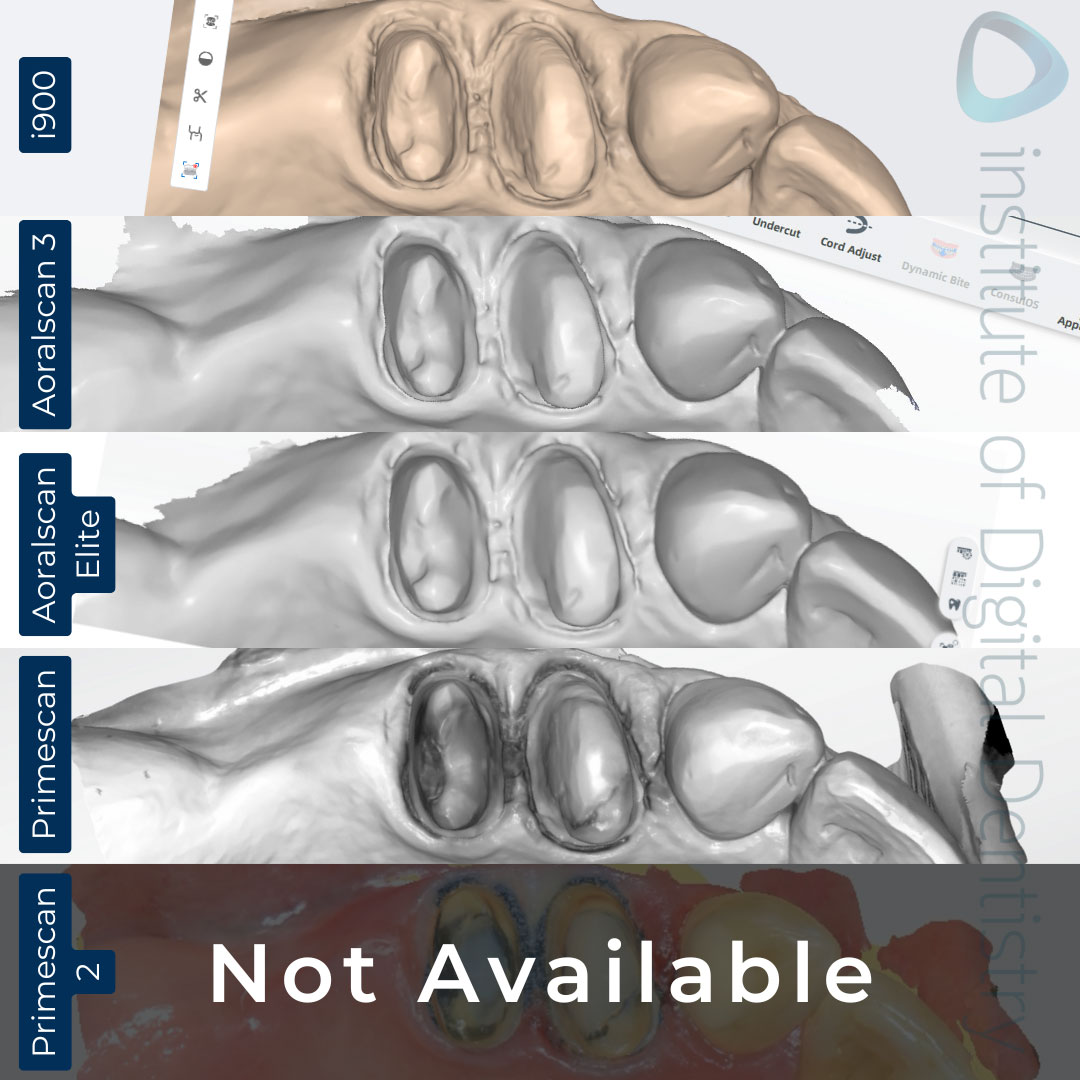
Medit i900 shows excellent margin capture and consistent detail across the scan field when viewing in monochrome.
Aoralscan 3 has good detail capture but slightly less definition compared to the Elite. Aoralscan Elite has crisper detail with better margin definition when comparing the monochrome scans to its predecessor, the Aoralscan 3, particularly in supragingival areas.
Again, similar to its color scan counterpart, Primescan displays the most detail even when viewed in monochrome. The scans resolution is high and shows sharp details. Primescan 2 does not offer monochrome viewing in its native software - an interesting omission from its feature set.
Alternatively, you can always export the STL file, which will ‘lose’ the color data.
Exported Scans
All intraoral scanners are open and allow scans to be exported and sent to labs. By exporting the scans outside their native software, we can view the scans objectively without the customized color and optimized surface rendering of the individual scanner’s built-in software.
You can use any third-party CAD software to examine the amount and detail of data captured in each scan; in this case, we used Medit Design.
File Formats and Sizes
These scans are usually exported in three various formats - STL, PLY or OBJ files.
STL files are exported as monochromatic scans, whereas OBJ and PLY files store color (texture).
Not all intraoral scanners can export OBJ files, whereas STL, and these days, PLY files are widely used by most companies.
If you want to learn more about these file types - read our blog on this topic here.
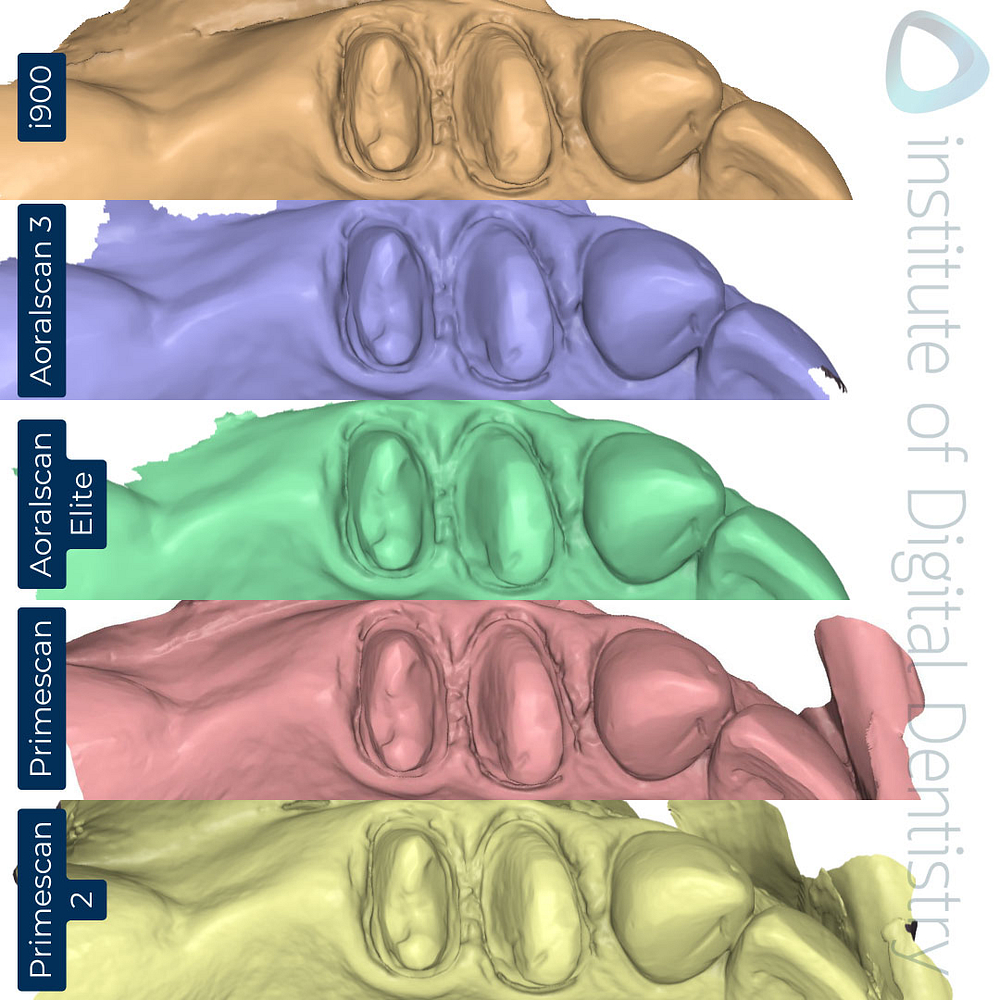
This particular set of scanners is capable of exporting scans in these formats:
- Medit i900, SHINING 3D Aoralscan 3 & Aoralscan Elite: Most versatile with STL, PLY, and OBJ export options.
- CEREC Primescan: STL (and PLY can be exported if connected via DS core / DS connect)
- Primescan 2: STL, and PLY and through DS Core
Intraoral Scanner | STL | PLY | OBJ | DXD |
|---|---|---|---|---|
Medit i900 | 10 MB | 4.1 MB | 9.9 MB | - |
SHINING 3D Aoralscan 3 | 7.5 MB | 7.5 MB | 10 MB | - |
SHINING 3D Aoralscan Elite | 6.9 MB | 7 MB | 9.3 MB | - |
CEREC Primescan | 13.5 MB | - | - | 52.2 MB |
Dentsply Sirona Primescan 2 | 13.3 MB | 12.8 MB | - | 53.5 MB |
Mesh Density Analysis
Based on the table above, we can see that there is a significant difference of the file sizes between each IOS.
The higher resolution or encoding of larger-sized objects requires more facets (triangles within the tessellation) to cover the 2D surface of the scan. Labs often use third-party CAD software like exocad. In this case, we used Medit Design to preview the received STL, PLY, or OBJ files and to take a closer look at the amount and detail of data captured within each scan.

So we can summarise the mesh density in relation to the file size as follows:
- Primescan 1: Highest density mesh, correlating with its larger file sizes
- Primescan 2
- Medit i900
- Aoralscan 3 and Aoralscan Elite are around the same
It's important to note that while higher mesh density can provide more detail, it doesn't always correlate directly with accuracy or clinical outcomes.
Margin Analysis
This software can also review prep margins. Clear margin capture is crucial for the fit of final restorations.
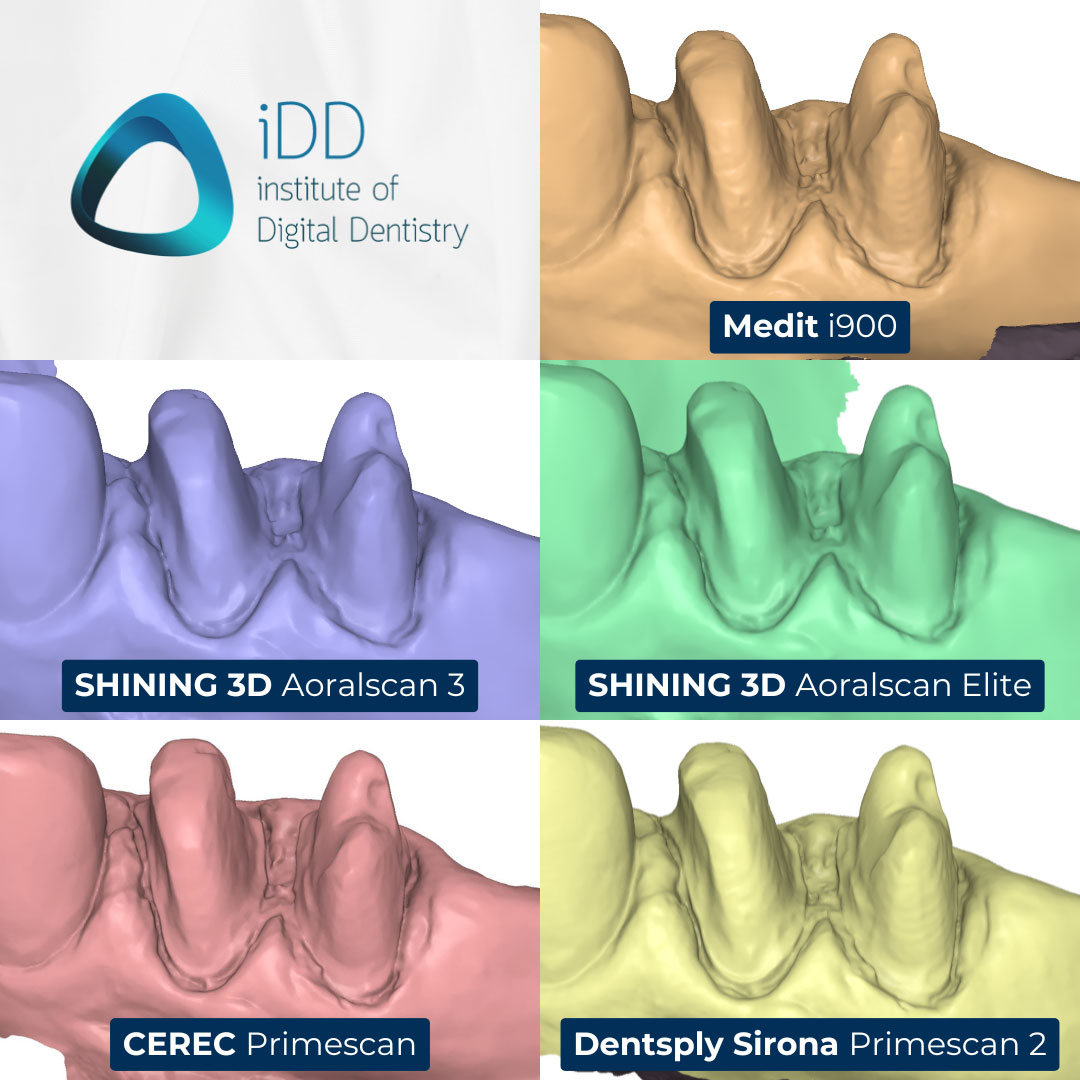
Buccal view

Palatal view
Here's how the scanners performed:
Medit i900 shows very clear margin lines, which indicate its good performance in both supragingival and slightly subgingival areas. This sharp margin detail is particularly visible in the buccal and palatal aspects.
With the Aoralscan 3, there is a reliable margin capture; however, it is slightly less definitive in deep subgingival regions than i900 or Primescan 2. Aoralscan Elite performed similarly to its Aoralscan predecessor, Aoralscan 3, but showed some minor variations in deep subgingival areas. Still very good overall.
Primescan appeared to have the most detailed or prominent margin line visible across all areas. Numerous research and data corroborate this (read it here). The files sizes from PS 1 are also the largest.
Like its predecessor, Primescan 1, Dentsply’s Primescan 2 also captures sharp margin definition, with excellent detail in subgingival areas, and consistent clarity around the prep sites. This aligns with its being the second densest STL file size at 13.3 MB, only 0.2 MB smaller than PS1 at 13.5 MB, and does well to follow in its predecessors' footsteps.
All scanners work well and are fast to use in this simple crown scan.
Deviation Analysis
When looking for deviations, we allocated Primescan as our reference point to compare all other scanners. The sectional view of the crown preps revealed minimal differences between the scans, suggesting high consistency across all devices.
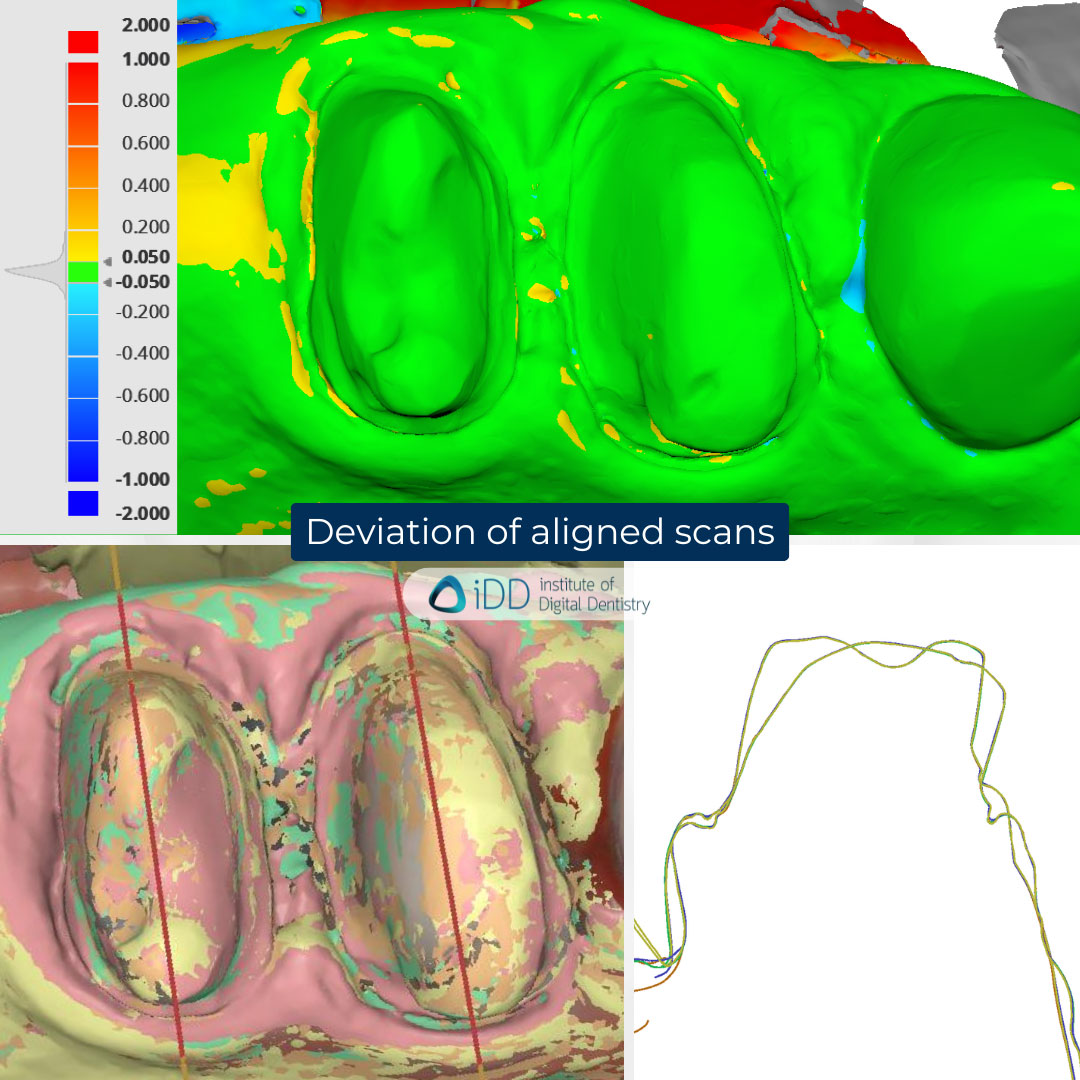
Key Takeaways
After thorough testing and analysis, it's clear that each of these scanners brings unique strengths to the digital dentistry workspace:
Medit i900 proves itself as a good all-rounder, offering great performance and a comprehensive software suite at a competitive price point. Its lightweight design and robust feature set make it a strong contender for practices of any size. Only thing it does not excel in, is very difficult edentulous scanning.
SHINING 3D's Aoralscan 3 represents great value, particularly for practices entering the digital workflow. While it may not lead in every category, it delivers reliable performance for most clinical applications.
SHINING 3D's Aoralscan Elite brings innovation to the market with its ultra-lightweight design, and more importantly, intraoral photogrammetry technology. It shows how far scanner ergonomics have come and sets a new standard for IOS. Great software too.
CEREC Primescan continues to set the bar for accuracy and detail, which is particularly valuable for same-day dentistry. High resoultion scans with crisp details. When paired with a CEREC milling unit, it remains one of the best solutions for single-visit dentistry.
Dentsply Sirona Primescan 2 demonstrates Dentsply Sirona's commitment to innovation with its cloud-based approach. While it carries a premium price tag, it offers good scan quality and potentially represents the future direction of digital impressions. You need a great internet connection though and interesting the scans dont look as high res as Primecan 1.
When selecting between these scanners, consider:
- Your budget and intended ROI
- Specific clinical needs and typical case types
- Desired workflow integration
- Importance of ergonomics vs features
- Future scalability requirements
All five scanners can produce clinically acceptable results for crown and bridge applicatons. The choice ultimately depends on your specific practice needs, workflow preferences, and budget constraints.
We encourage readers to share their experiences with these scanners and welcome suggestions for future comparisons. The field of digital dentistry continues to evolve rapidly, and staying informed about the latest developments helps ensure the best outcomes for both practitioners and patients.
Remember to always request a demonstration and hands-on trial before making your final decision. Personal experience with these devices can be invaluable in determining the best fit for your practice.

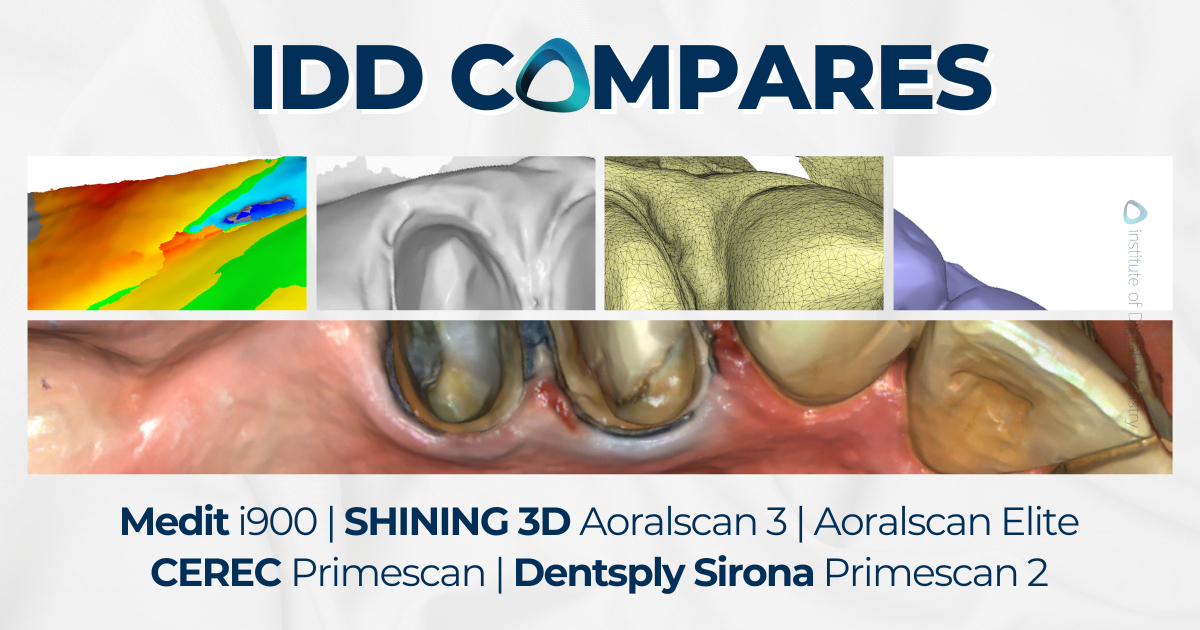
Want to know about online training program
Learn about all our education and training here – https://instituteofdigitaldentistry.com/idd-courses-overview/
You can definitely export obj files from Shining when uploaded to the cloud.
Great as always, just wondering why no trios scanners.
Check out our other compares posts! We often compare TRIOS but sometimes its nice to see how other scanners perform.
I thought that the Aoralscan 3 offered the most photorealistic scans. I have a Medit i700 and a Medit i500. Both do a great job. I see you did not rate any of the (dogs) Dexis 3700 or 3800 scanners. They may have Dexis branding but they are still Carestream inside.
Thanks for your comment! You’re right – the Aoralscan 3 does produce impressively photorealistic scans. It’s one of the standout features of that scanner. The Medit i700 is also solid performers and continue to be great value for many clinics. Personally I would not recommend i500 anymore in this market. It was great for its time but there are much better options now.
As for DEXIS, the 3700 and 3800 are indeed rebranded Carestream scanners because DEXIS bought that part of the company. We’ve covered their lineup in previous iDD comparisons, so feel free to check those out on our site if you’re interested in a deeper dive.
Thank you very much for your exzellent work. As a long time user ( started with CEREC in 1994) it is great to see todays scope of possibilities compared against each other. Great work✌️
You’re very welcome and thank you for your kind words! It means a lot coming from someone with such deep experience in the field. It’s incredible how far we’ve come since the early days of CEREC in 1994 — and even more exciting to imagine where we’re headed next. Glad you found the comparison helpful! ✌️
Nicely outlined, practical tips